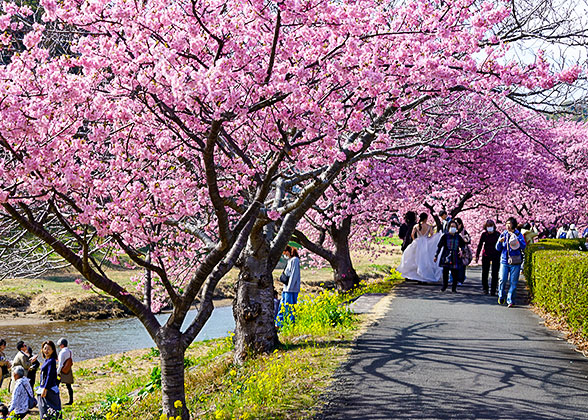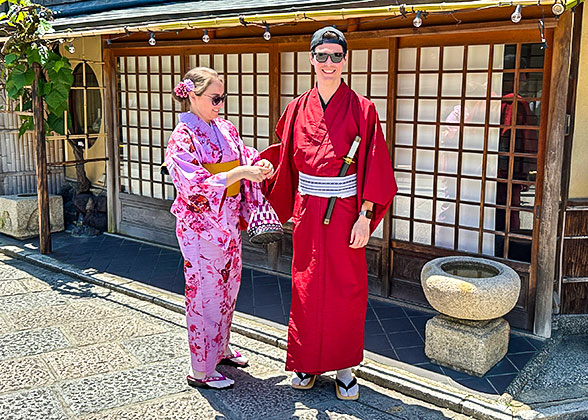Wakayama Attractions
Wakayama Prefecture lies in southwestern Kansai region with sea on three sides. It’s next to Osaka and Nara with complex landforms and beautiful seascapes. In addition, its rich history and pilgrim culture leaves the place a number of ancient temples and shrines and makes the land sacred and charming, attracting numerous tourists all year round.

Kumano Kodo
|
Attractions in Wakayama are mainly in four regions: Wakayama City, Shirahama, Kumano Kodo Pilgrim Routes and Mount Koya.
Attractions in Wakayama City, Northwest Wakayama
1. Wakayama Castle
Wakayama Castle was first built under the command of Toyotomi Hideyoshi - a warlord and unifier of Japan in 1585, and was rebuilt just as the initial one in 1958. Situated on Mount Torafusu, the castle features stone fortifications and white walls surrounded by over 600 cherry trees and other plants, which makes it an attractive place for admiring cherry blossoms in spring and foliage in fall. From the top of the castle tower, visitors can get a panoramic view of the whole city of Wakayama.

Wakayama Castle
|
2. Kuroshio Market
Kuroshio Market is a seaside fish market, selling seasonal seafood and Japanese sake. The layout of the market models after a shopping area of the 1950s to 1960s, which gives a nostalgic ambience to it. Also nicknamed as “Tuna Land”, the daily tuna cutting shows in the market bring visitors a close contact to freshly caught tuna, and you can try some fish dishes like sushi and sashimi here.

Kuroshio Market
|
3. Kimiidera Temple
Kimiidera Temple, one of the most popular temples in Wakayama, is famous for its traditional buildings, wells and 1,200 cherry trees. Its name comes from the three wells in it: the Well of Purity, the Well of Healing and the Well of Good Fortune. Also you can admire Japan’s largest wooden Kannon statue in Kimiidera Temple.
|
|
|
4. Kishi Station
Kishi Station is famous for Tama – a cute calico cat which is the Honorary Eternal Stationmaster of it. This small station is just like a cat’s head, with a lot of cat patterns and cat-related souvenirs inside. You may take one of the four lovely cat-themed trains on Kishigawa Line from Wakayama Station to Kishi station and meet the cat stationmaster.5. Kishu Toshogu Shrine
There are many Toshogu Shrines in Japan which enshrine Tokugawa Ieyasu (1543-1616) - the founder of the Tokugawa shogunate. Kishu Toshogu Shrine is over 400 years old, in which the Wakamatsuri - the biggest traditional festival in Wakayama - is held every year.

Kishu Toshogu Shrine
|
6. Tomogashima Islands
Used to be a military fort during World War II, Tomogashima is composed of four islands near Kada Port, to the west of Wakayama City. On the islands you can see the abandoned military installations shaded in green trees and weeds. This place attracts not only history buffs but also anime fans because it has a highly similar appearance with Laputa - the floating island in the animated movie Castle in the Sky.What to See in Shirahama, Southwest Wakayama
1. Nanki-Shirahama Onsen
Nanki-Shirahama Onsen, also named as Shirahama Onsen, is on the west coast of the Kii Peninsula by Shirara Beach. Along with Dogo Onsen and Arima Onsen, it’s one of the three oldest hot springs in Japan. The seaside Saki-no-Yu’s outdoor rock bath has been popular for centuries, even an emperor used to take hot spring bath here.
|
|
|
2. Shirara Beach
Shirara Beach is one of the best beaches in Japan known for its white sand and clear water. The arched beach is 620 meters (2034 ft.) long with stunning seascape. The fireworks displays every summer also make the beach lively and joyous. The above Nanki-Shirahama Onsen is on the beach. Also, you may enjoy seafood and sea sceneries here.3. Engetsu Island
Engetsuto Island, officially named as Takashima, is an uninhabited island off the coast of Shirahama. The name “Engetsu” stands for full moon in Japanese, indicating its circular hole created by wind and waves. The sun shines right through the circular hole at sunset. What a remarkable spectacle!4. Senjojiki
Senjojiki, which means a thousand tatami mats, are rock formations eroded by continuous waves of the Pacific Ocean. The sand rocks are uneven with strange shapes while the surfaces are smooth. You may stroll on the rocks to the seaside cliffs, exploring the beauty made by nature.

Senjojiki
|
5. Sandanbeki
Sandanbeki is a series of rock cliffs stretching for about 2 kilometers (1.2 mi.) along the coast of Shirahama. There is a cave under the cliff called Sandanbeki Cave, which is a spot for pirates of the Heian period (794-1185) to hide their boats. Visitors are welcome to admire the grand rock cliffs and explore the inner cave.

Sandanbeki
|
Attractions along Kumano Kodo Pilgrim Routes
Stretching from Mount Koya, Kumano Kodo is the term for 6 ancient trails through the primordial forest and along the coast to Kumano Sanzan - three Grand Shrines. For over 1,000 years, people of all classes have taken these pilgrimage roads to worship at the three shrines, making Kumano Kodo an important part of the Kumano faith. Walking through mountains and woods, the sacred atmosphere will definitely give you a spiritual purification and relaxation.

Kumano Kodo Hiking with Sakura
|
1. Kumano Sanzan
Kumano Sanzan refers to the three Grand Shrines connected by the pilgrimage route Kumano Kodo: Kumano Hayatama Taisha Grand Shrine, Kumano Hongu Taisha Grand Shrine and Kumano Nachi Taisha Grand Shrine, which have been all listed as UNESCO World Heritage sites “Sacred Sites and Pilgrimage Routes in the Kii Mountain Range” since 2004. These three shrines enshrine their own gods and the gods of the other two. Since the Heian period (794-1185), people have been making pilgrimages to the holy land on foot.
|
|
|
2. Nachi Waterfall
Being a part of the World Heritage Site along with Kumano Sanzan and Kumano Kodo, Nachi Waterfall is Japan’s tallest waterfall with a drop of 133 meters (436 ft.) and a width of 13 meters (42.6 ft.). Located near Kumano Nachi Taisha Grand Shrine, this waterfall is considered to be the dwelling place of a kami - literally god.
|
|
|
3. Hashiguiiwa Rocks
Inside Yoshino-Kumano National Park along Pilgrim Routes, Kumano Kodo Hashiguiiwa Rocks are designated as Japan’s natural monument. Formed by the magma 14 million years ago, Hashiguiiwa Rocks consist of about 40 columnar rocks extending 850 meters (0.5 mi.) from the coast to the sea. The grotesque rocks stand in the sea just like piers, which is especially imposing at low tide.Best Places to Go on Mount Koya, Northeast Wakayama
Bordering Osaka, Mount Koya is a sacred mountain with rich cultural and historical heritages. Housing over 100 temples, it’s one of the biggest Buddhist sanctuaries in Japan. Kongobuji Temple, the head temple of Koyasan Shingon Buddhism, and Okunoin Temple, the mausoleum of Kobo Daishi, are the most representative sites to visit on Mount Koya.
|
|
|
Besides, there are over 50 temples on Mount Koya offering Shukubo - temple lodgings. Visitors or pilgrims can spend a unique night in a traditional Japanese room of a temple. You may also experience vegetarian Buddhist cuisine, ajikan meditation and sutra copying. It’s a rare opportunity to get a taste of the lifestyle of Buddhist monks that no other hotels can offer.
See more:





